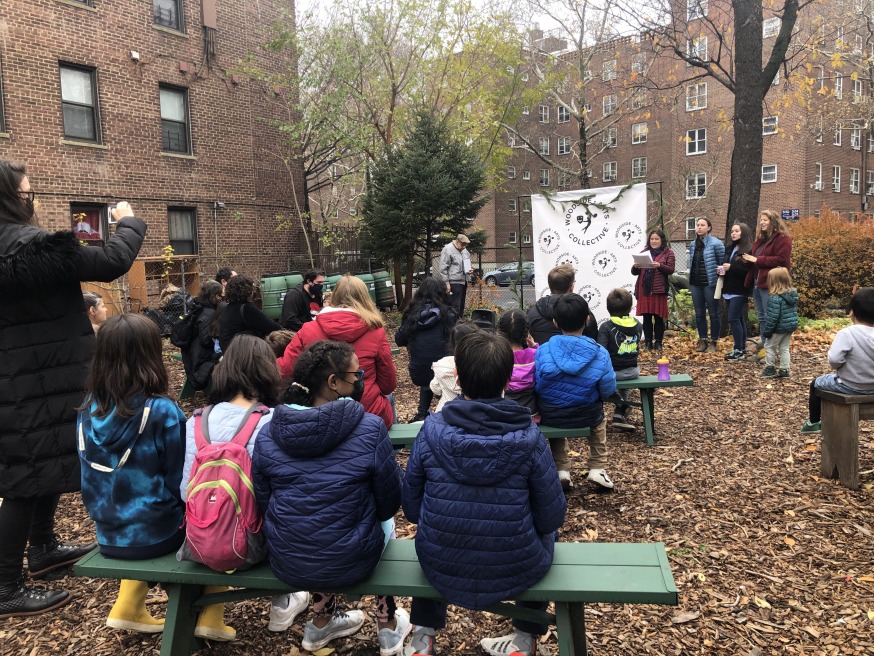
The raised gardens at Moore-Jackson Cemetery and Community Garden (Photo: Sarah Kerson)
Jan. 14, 2022 By Sarah Kerson
In 2017, two Woodside residents came together with one goal in mind: to clean up a historic site on 51st Street across from the Woodside Houses that had become an eyesore.
“It was so overgrown,” said Elizabeth O’Connor, who with her then-neighbor Samantha Yeung organized efforts to create a community garden on a lot that remains home to an 18th century family cemetery. “I couldn’t get over how much garbage people dropped here.”
O’Connor and Yeung began with community outreach sessions in O’Connor’s Woodside apartment to hear from neighbors about their visions for the overgrown lot—long known as the Moore-Jackson family cemetery—located on 51st Street, between 31st and 32nd avenues.

The Moore-Jackson Cemetery and Community Garden is located on 51st Street between 31st and 32nd avenues (GMaps)
The property is owned by the Queens Historical Society, and the pair got the permission of the organization before moving ahead with their plans. The site includes a graveyard—with historic headstones—on a portion of the property.
Local volunteers and representatives from GrowNYC helped build raised beds and outdoor furniture such as benches. Last year, the Astoria Woodworkers Collective helped build a puppet theater, and the Island Bee Project added two beehives to the space.
Today, the site, officially called the Moore-Jackson Cemetery and Community Garden, produces enough vegetables that some are distributed to Sunnyside-Woodside Mutual Aid, a neighborhood organization that offers food to those in need and maintains a free community fridge.
But long before the community garden, the land was home to the Moore-Jackson families and included their Dutch farmhouse that was on the property from 1705 to 1901. The house was demolished, but several family gravestones remain on the grounds to this day.

The headstones at the Moore-Jackson cemetery (Photo: Sarah Kerson)
Writing for the Queens Historical Society in 1999, Celia Bergoffen described the Moores as “a family of wealthy landowners who played a prominent role in Queens’ history.”
Meanwhile, the Jacksons were another wealthy family at the time – with one of them marrying into the Moore family.
Jason Antos, the interim director of the Queens Historical Society, said the Moore-Jackson cemetery is one of the oldest family cemeteries still in existence in Queens. Such places were once commonplace across the country, he said.
“There was really no established cemetery business until the 1800s,” he said. Antos said most family cemeteries have since been lost to development. “But the Moore-Jackson is one of the rare ones that survived just by sheer luck.”
A surviving descendant of the Moore family sold the land to the Queens Historical Society in 1999 for one dollar. It became a city landmark in 1997 and remained a mostly unused lot for 20 years.
“This was a dump four years ago, and now it’s this amazing community center that draws people together and gives people access to fresh food and access to green space,” said Jessica Coyle, a composting volunteer at the garden. “I mean, what an astounding thing to have done.”
The garden hosts events for community members, like a holiday market in December where local Queens vendors sold artwork, crafts and gifts.
O’Connor said the garden drew a significant number of volunteers during the pandemic. They began compost collection last year when the city stopped its operations.
“So many people were craving interaction with others and outdoor space,” she said. “I just wanted to be around other people.”

Community events are often held at the garden (Photo: Sarah Kerson)
2 Comments

Nice job! Something positive in our community. Not that easy to get things done.
When is it open to the public?